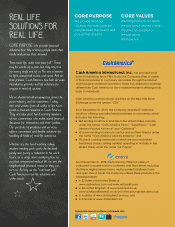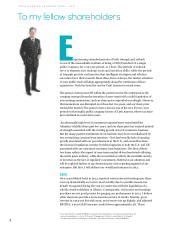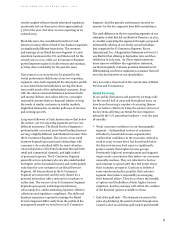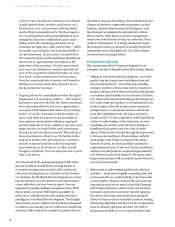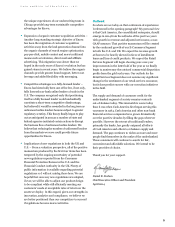Cash America 2013 Annual Report Download - page 6
Download and view the complete annual report
Please find page 6 of the 2013 Cash America annual report below. You can navigate through the pages in the report by either clicking on the pages listed below, or by using the keyword search tool below to find specific information within the annual report.to both owners of gold (our customers) and dealers
of gold (pawnbrokers, jewelers, gold buyers, etc.).
By mid-year 2012, our customers had liquidated
much of their unwanted jewelry. We then began to
see our gold purchases drop and redemption rates
strengthen on jewelry-collateralized pawn loans –
telling us that the remaining gold assets of our
customers are items they really want to keep – which
is actually a good thing for the long-term health of
our pawn business. In 2013 alone, our prot from
the commercial sale of gold and diamonds fell from
2012 levels by approximately $41 million or the
equivalent of 84¢ per share. We have experienced
year-over-year declines for commercial prots for
each of the six quarters ending December 31, 2013.
As a result, we have transitioned our focus away
from the commercial sale of jewelry and toward an
initiative to increase retail sales of jewelry in our
bricks and mortar locations.
• Ongoing efforts for consolidation within the highly
fragmented U.S. pawnshop industry – The industry
disruption created by the rst two items mentioned
above has opened the door for new opportunities
to acquire small independent chains of pawnshops
in the U.S. In the 18 months ended December 31,
2013, Cash America acquired 109 pawnshops in
four separate transactions totaling an aggregate
purchase amount of $235.5 million. I am sure some
might ask why we would make such investments
during a period of industry turmoil. The wisdom of
these investments is clear to us. We believe in the
long-term health of the pawn business, and these
periods of turmoil motivate sellers to negotiate
reasonable prices for shops we or others would
struggle to duplicate. We view this period as a great
time to be buyers.
As I referenced in the opening paragraph of this letter,
periods of setback should always prompt leaders to
re-examine strategy and execution with a newfound
critical eye. Having done so, I can tell you that I believe
our strategies for the Retail Services Segment are sound,
but our execution over the past two years has not been
on par with what you have come to expect from our
experienced, market-leading management team. With
that in mind, our senior eld leaders assembled in
mid-year to critically examine the existing execution
paradigms of our Retail Services Segment. That lengthy
and extensive review yielded several initiatives designed
to enhance our customer service culture and sharpen the
execution skills required to compete for greater share in
all markets. Among other things, these initiatives involve
changes in incentive compensation programs, revised
training, systems enhancements and changes in work
ow designed to minimize the administrative duties
that we believe often distract our store management
teams away from directly serving our customers. None
of this is revolutionary. It is simply designed to regain
the execution muscle we allowed to atrophy during the
comfortable years of the gold rush. You will see better
execution from us going forward.
E-Commerce (Enova)
The current state of the E-Commerce Segment of our
enterprise can also be framed by a handful of major themes:
• Migration from the traditional single-pay, two-week
payday loan into longer-term installment loan and
line of credit products – One of the long-standing
strategic objectives of Enova has been to broaden its
product offering with credit products that offer greater
convenience and exibility for its customers. In those
U.S. states with statutes restricting product design to a
two-week, single-pay product, we recognized this sole
product option often did not give some consumers
enough money or repayment runway to effectively
meet their individual needs. We began to look for
statutes in the U.S. that would allow viable installment
or line of credit lending. At the same time, we were
expanding our product set in the UK to include an
installment loan option and now a line of credit
option. What we have learned through these processes
is that one size and avor of loan seldom really ts
what people want. When we acquired the online
business in 2006, its entire portfolio consisted of
single-payment loans. At the end of 2013, installment
and line of credit products comprised approximately
71% of Enova’s gross loan balances. We expect those
longer-term products will account for most of Enova’s
near-term asset growth.
• Renement of underwriting models and collection
activities – In periods of rapidly expanding asset and
revenue growth, we would normally expect loss rates
to move higher. That has not been the case in recent
reporting periods as loss rates for both the Domestic
and Foreign businesses of Enova have moved lower.
Customer and product mix factor into the equation,
but much of the improvement has been primarily
driven by the success of our analytics team in rening
decisioning algorithms and the work of our operations
team in rening collections practices. We believe
the growing breadth of our consumer database and
4


